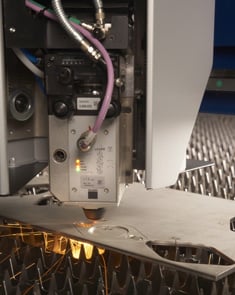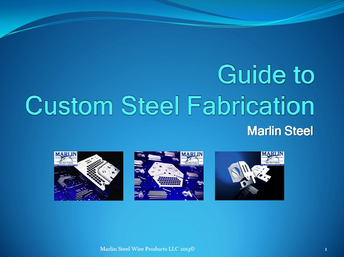 Metal-cutting lasers are incredibly useful tools for Marlin’s production team—largely because they can make micrometer-precise cuts in sheet metal of varying thicknesses without causing excessive distortion at the site of the cut.
Metal-cutting lasers are incredibly useful tools for Marlin’s production team—largely because they can make micrometer-precise cuts in sheet metal of varying thicknesses without causing excessive distortion at the site of the cut.
Compare this to CNC punches, which use physical force to shear metal away from the site of the cut. Even with extremely sharp and strong presses, the stress of cutting sheet metal of any appreciable thickness will result in some mechanical deformation of the work piece—the thicker the metal being cut, the worse the distortion will be.
Because laser cutting doesn’t rely on physical force, it can separate metal without creating a torn or uneven edge. This allows for cuts in sheet metal to be made close together—which means being able to make more parts per piece of sheet metal being cut.
Also, while the cutting edge of a CNC punch can wear out, a laser cutting machine doesn’t have a blade to damage.
So, what kind of sheet metal products can this touch-free manufacturing equipment produce?
Sheet Metal Tags
One common use of laser cutting equipment is to create the laser-cut sheet metal tags that many manufacturers use to differentiate similar parts handling/washing baskets. With these extra tags, visually identifying baskets that have similar appearances but distinct uses becomes much easier.
Engraved Sheet Metal
At lower power settings, it’s possible to use a laser cutting machine to only partially cut into a piece of sheet metal—leaving a smooth, regular groove in the surface. Laser engraving allows manufacturers to leave a fine, but distinctive mark on their sheet metal products. One customer used this functionality to create a custom engraving for a series of pizza oven faceplates to be used in custom-made ovens to be used in restaurants across the world.
Cut Sheet Metal Baskets
Normally, wire mesh baskets are the go-to solution for parts washing and other manufacturing processes that heavily rely on air/liquid flow to complete successfully. However, in some cases, it may be better to use thicker, sturdier sheet metal with holes cut into it than dozens of individual steel wires.
Laser-cut sheet metal baskets can have incredibly intricate shapes cut into them to meet specific needs. However, the strength advantage of these metal baskets is maximized when there are fewer holes spaced farther apart rather than many holes spaced close together.
Cut-Out Parts
Laser cutting is also frequently used for making small cutouts from a larger piece of sheet metal. These cutouts are then used as small, flat parts for other products.
For example, small cutouts could be made into computer drive mounts or miniature fan blades with additional work using a CNC press brake or other metal forming equipment.
Why Use Laser-Cut Parts?
The primary reason to use laser cutting techniques is to reduce the mechanical stress that a sheet metal form experiences while being cut. Not only do lasers eliminate the impact stress that can adversely affect sheet metal products during cutting, the heated zone is incredibly tiny. This means that the rest of the work piece is exposed to little or no heat, preserving the properties of the material being handled.
Also, because laser cuts can be made very close to one another without negatively impacting the sheet metal, they help minimize waste—closer cuts allow you to make more parts per square foot of sheet metal you use.
However, CNC punches do have a place on a modern manufacturing shop. In some applications, such as making bent sheet metal forms, the CNC punch’s ability to bend the metal rather than simply cutting it can be an invaluable asset for rapid production.
Want to learn more about the benefits of using laser cutting for manufacturing? Check out our laser cutting page! For more information about sheet metal fabrication, please download our guide at the link below:



.gif)


